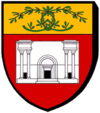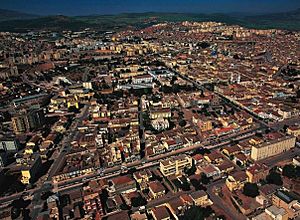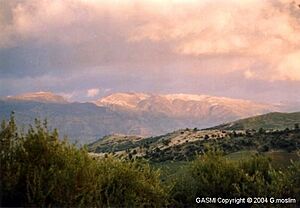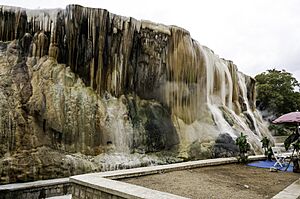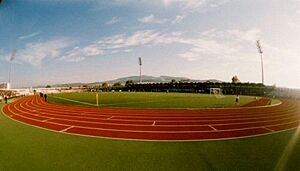Guelma facts for kids
Quick facts for kids
Guelma, Calama, Qālima
قالمة, ڨالمة
|
||
|---|---|---|
| City of Guelma | ||
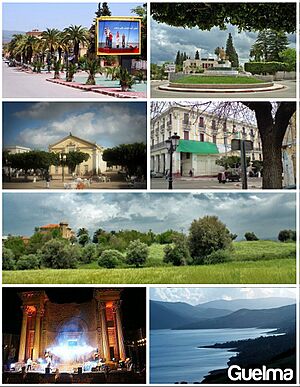
From top left to bottom right clockwise: Souidani Boudjemmâa Boulevard, province administration, municipal theater, St. Augustine Place, Oued Maïz Road, the Roman theater, and Lake Bouhemdane
|
||
|
||
| Nickname(s):
La ville assiette (The Basin City)
|
||
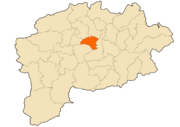
Location of Guelma in the Guelma Province
|
||
| Country | ||
| Province | Guelma (seat) | |
| District | Guelma (seat) | |
| Area | ||
| • Total | 44.74 km2 (17.27 sq mi) | |
| Elevation | 256 m (840 ft) | |
| Population
(2008)
|
||
| • Total | 120,004 | |
| • Density | 2,682.25/km2 (6,947.0/sq mi) | |
| Time zone | UTC+01 (CET) | |
| Postal code |
24000
|
|
| ONS code | 2401 | |
Guelma is a city in north-eastern Algeria. It is the capital of both Guelma Province and Guelma District. The city is about 65 kilometers (40 miles) from the Mediterranean Sea. Guelma is built on the site of an ancient city called Calama.
Contents
History of Guelma
Guelma has been settled by people since very early times. It became a town under the Phoenicians, an ancient civilization. They called it Malaca, which might have meant "salt." Later, the Romans took over the area. They renamed the town Calama. It was part of the Roman province of Numidia.
Ancient Times
Calama grew and became important when Christianity spread. A famous Christian leader, Saint Possidius, was a bishop in Guelma in the 400s.
Later, the Vandals invaded and caused a lot of damage. When the Byzantines arrived, they built strong city walls. These walls helped protect the community from more attacks. However, after the Islamic conquest of Algeria, the area was left without a formal town for a long time. This continued even during the time of Ottoman rule.
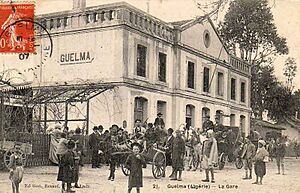
French Rule
Guelma became a formal town again during the French colonization of Algeria. This happened after seven centuries of being abandoned. The French Army first explored the ruins of Calama in 1836. This was when they were moving towards Constantine.
Guelma was officially established as a city in 1836. French settlers helped it grow quickly. A modern city developed around the old Roman ruins. It first grew inside the restored Byzantine walls. Later, it also expanded outside the walls. The city also grew near the railroad, which went through it.
The Roman theater in Guelma was repaired in 1905. During this time, many European settlers lived in the city. This was part of the French colonial plan. In 1945, during the Sétif massacre, many settlers were killed. Guelma's oldest religious building still used for worship is the El-Atik Mosque. It was built in 1837. Guelma also had a synagogue for local Jewish people. There was also a church for Christian European settlers.
After Independence
After Algeria became independent, most European settlers and Jewish people left. The synagogue and the church were changed into mosques. The number of people living in Guelma grew very fast after independence.
Geography and Climate
Guelma is in a very important farming area. It is 290 meters (950 feet) above sea level. Mountains like Maouna, Dbegh, and Houara surround it. The land is very fertile because of the Seybouse River. A large dam helps water the farms.
Guelma is also in a key spot in north-eastern Algeria. It connects the coast (like Wilaya of Annaba, El Taref, and Skikda) to inland areas (like Wilaya of Constantine).
Guelma's Climate
Guelma has a hot-summer Mediterranean climate. This means it has hot, dry summers and mild, wet winters. It rains more in winter than in summer. The average temperature in Guelma is about 17.2°C (63°F) each year. About 557 millimeters (22 inches) of rain falls every year.
| Climate data for Guelma | |||||||||||||
|---|---|---|---|---|---|---|---|---|---|---|---|---|---|
| Month | Jan | Feb | Mar | Apr | May | Jun | Jul | Aug | Sep | Oct | Nov | Dec | Year |
| Mean daily maximum °C (°F) | 14.3 (57.7) |
15.4 (59.7) |
18.1 (64.6) |
20.5 (68.9) |
25.2 (77.4) |
30.5 (86.9) |
34.4 (93.9) |
34.5 (94.1) |
29.8 (85.6) |
24.9 (76.8) |
19.3 (66.7) |
15.7 (60.3) |
23.6 (74.4) |
| Mean daily minimum °C (°F) | 3.6 (38.5) |
4.6 (40.3) |
6.1 (43.0) |
8.0 (46.4) |
11.4 (52.5) |
15.0 (59.0) |
17.8 (64.0) |
18.9 (66.0) |
16.9 (62.4) |
12.8 (55.0) |
9.2 (48.6) |
5.8 (42.4) |
10.8 (51.5) |
| Average precipitation mm (inches) | 82 (3.2) |
60 (2.4) |
55 (2.2) |
44 (1.7) |
40 (1.6) |
25 (1.0) |
3 (0.1) |
12 (0.5) |
26 (1.0) |
49 (1.9) |
70 (2.8) |
91 (3.6) |
557 (21.9) |
| Source: Climate-Data.org, Climate data | |||||||||||||
Industry and Economy
Guelma has several industries. These include making bicycles and mopeds. They also refine sugar, make ceramics, can food, and mill semolina. Guelma is also known for traditional crafts. These include knitting and making pottery.
Fun Things to Do in Guelma
There are many fun places to visit near Guelma. These include natural hot springs. Hammam Debagh is about 20 minutes away. Hammam Ouled Ali has two resorts and offers services for visitors.
Some hotels in the area are:
- Hotel Mermoura
- Hotel Tarik
- Hotel Chelala (in Hammam Debagh)
- Hotel la Couronne
- The El Baraka tourist complex (which includes Hotel A/B)
- The Bouchahernie tourist complex
Sports in Guelma
Guelma has many sports places. These include:
- The Olympic Stadium
- The Municipal Stadium
- An Olympic swimming pool
- A multi-sports hall
Football (soccer) is the most popular sport in Guelma. It is popular throughout Algeria.
Guelma has several football clubs:
- Espérance Sportive de Guelma (ES Guelma), started in 1939
- The Olympic Football Guelma, started in 1947
- L'Ettardji Sarri Madinet Guelma, started in 1977
Media and News
Guelma does not have its own local TV channels or newspapers. However, Radio Algérie runs a radio channel in Guelma.
Famous People from Guelma
- Chafaa Abdelmajid: An author, playwright, and teacher. He was a leader in Algeria.
- Slimane Benaissa: A playwright and dramatist.
- Kateb Yacine: A famous Algerian writer. He was born in 1929 and died in 1989.
- Houari Boumediene: He was the President of Algeria from 1965 to 1978. He helped Algeria become strong after its war for freedom from France.
- Abdallah Baali: An Algerian diplomat.
- Taieb Boulahrouf: A member of the FLN before independence. He later became Algeria's ambassador to several countries.
- Saddek Boussena: A former energy minister and a past president of OPEC.
- Charles-Michel Marle: A French mathematician, born in 1934.
- Bettina Heinen-Ayech: A painter (1937-2020).
- El-Eulmi: The first General Secretary of the Presidency during Bouteflika's first time as President of Algeria.
- Henri Médus: A French opera singer (1904–1985).
See also
 In Spanish: Guelma para niños
In Spanish: Guelma para niños


